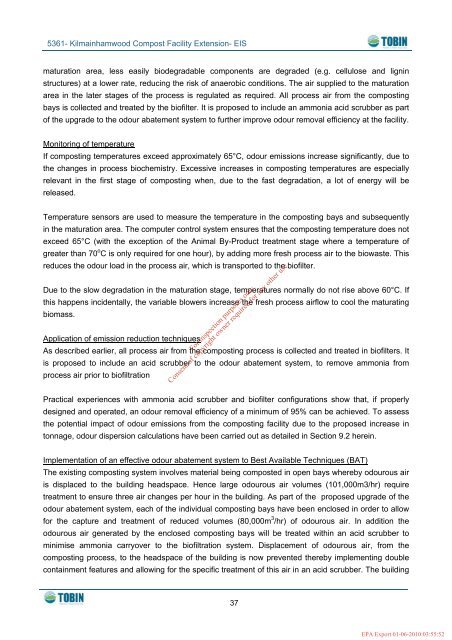environmental impact statement kilmainhamwood compost facility ...
environmental impact statement kilmainhamwood compost facility ...
environmental impact statement kilmainhamwood compost facility ...
Create successful ePaper yourself
Turn your PDF publications into a flip-book with our unique Google optimized e-Paper software.
5361- Kilmainhamwood Compost Facility Extension- EIS<br />
maturation area, less easily biodegradable components are degraded (e.g. cellulose and lignin<br />
structures) at a lower rate, reducing the risk of anaerobic conditions. The air supplied to the maturation<br />
area in the later stages of the process is regulated as required. All process air from the <strong>compost</strong>ing<br />
bays is collected and treated by the biofilter. It is proposed to include an ammonia acid scrubber as part<br />
of the upgrade to the odour abatement system to further improve odour removal efficiency at the <strong>facility</strong>.<br />
Monitoring of temperature<br />
If <strong>compost</strong>ing temperatures exceed approximately 65°C, odour emissions increase significantly, due to<br />
the changes in process biochemistry. Excessive increases in <strong>compost</strong>ing temperatures are especially<br />
relevant in the first stage of <strong>compost</strong>ing when, due to the fast degradation, a lot of energy will be<br />
released.<br />
Temperature sensors are used to measure the temperature in the <strong>compost</strong>ing bays and subsequently<br />
in the maturation area. The computer control system ensures that the <strong>compost</strong>ing temperature does not<br />
exceed 65°C (with the exception of the Animal By-Product treatment stage where a temperature of<br />
greater than 70 o C is only required for one hour), by adding more fresh process air to the biowaste. This<br />
reduces the odour load in the process air, which is transported to the biofilter.<br />
Due to the slow degradation in the maturation stage, temperatures normally do not rise above 60°C. If<br />
this happens incidentally, the variable blowers increase the fresh process airflow to cool the maturating<br />
biomass.<br />
Application of emission reduction techniques<br />
As described earlier, all process air from the <strong>compost</strong>ing process is collected and treated in biofilters. It<br />
is proposed to include an acid scrubber to the odour abatement system, to remove ammonia from<br />
process air prior to biofiltration<br />
For inspection purposes only.<br />
Consent of copyright owner required for any other use.<br />
Practical experiences with ammonia acid scrubber and biofilter configurations show that, if properly<br />
designed and operated, an odour removal efficiency of a minimum of 95% can be achieved. To assess<br />
the potential <strong>impact</strong> of odour emissions from the <strong>compost</strong>ing <strong>facility</strong> due to the proposed increase in<br />
tonnage, odour dispersion calculations have been carried out as detailed in Section 9.2 herein.<br />
Implementation of an effective odour abatement system to Best Available Techniques (BAT)<br />
The existing <strong>compost</strong>ing system involves material being <strong>compost</strong>ed in open bays whereby odourous air<br />
is displaced to the building headspace. Hence large odourous air volumes (101,000m3/hr) require<br />
treatment to ensure three air changes per hour in the building. As part of the proposed upgrade of the<br />
odour abatement system, each of the individual <strong>compost</strong>ing bays have been enclosed in order to allow<br />
for the capture and treatment of reduced volumes (80,000m 3 /hr) of odourous air. In addition the<br />
odourous air generated by the enclosed <strong>compost</strong>ing bays will be treated within an acid scrubber to<br />
minimise ammonia carryover to the biofiltration system. Displacement of odourous air, from the<br />
<strong>compost</strong>ing process, to the headspace of the building is now prevented thereby implementing double<br />
containment features and allowing for the specific treatment of this air in an acid scrubber. The building<br />
37<br />
EPA Export 01-06-2010:03:55:52

















